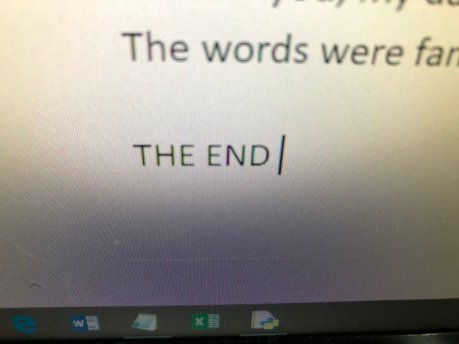 Hello again, friends!
Hello again, friends!So, as some of you may be aware, in November 2018 I used NaNoWriMo to write the first 50,000 words of my fantasy novel (it’s set in a Middle Ages style military matriarchy! I’m still very excited about that fact) and then by March 2019 I had a full novel draft of about 80,000 words.
I felt like the text needed a lot of clean up and revision before it could it could be shared with anyone, there were a lot of “[insert name here]” type things, which I felt would get in the way of people getting what the story was trying to do and enjoying the characters and so on. I wanted useful feedback, and at that stage the text was just too rough for an outsider to get a clear view of it.
A brief history of editing this novel
I spent March until August of 2019 rewriting the 80,000 words to make them better and more coherent. I restructured some things, rewrote A LOT of scenes, fleshed out the worldbuilding, changed some of the names. It was still the same draft, but it was far more readable and closer to the best version of the story I had in my head at that point.
The draft went out to alpha readers in August of 2019, right before I left to go to Worldcon in Dublin. I was desperate to make that deadline , even though I never really had time to rewrite the last 10,000 words, because I was going to be traveling for a few weeks overall, and wanted to be abroad while readers were going to read my book, a first-time-ever experience for me. I knew I’d be a nervous wreck, and I wanted to be distracted.
Amazingly, I actually heard back from most of my alpha readers by the time I landed in Dublin – something I was utterly unprepared for and had me scrambling to send follow-up questions while the story was still fresh in their heads.
When I came back from a very intense trip (Worldcon, then the Edinburgh Fringe Festival, then 5 days in London during which I saw and did approximately eight billion things, one of them being Hamilton! \o/) I went straight into my usual work schedule, plus intense rehearsals for a play I was in, and then a month later there was a huge local con I was heavily involved with, and well…
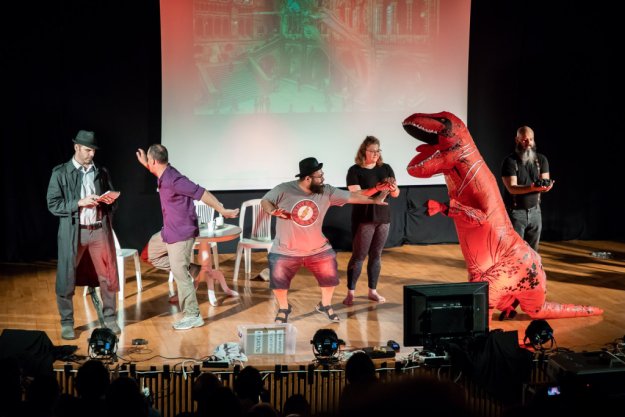
(A still from the play I was in, photographed by Nurel Zeevi. I was not on stage for this scene, but one of the people in the photo is a volunteer from the audience, not a cast member. I’ll leave it to you to guess who it is!)
I got around to working on the draft again around November, which was when I sat down and went over feedback, reread everything, created a new outline, and in December of 2019 I began working on the second draft of the book.
And now, here we are in April of 2020, and that draft is done!
What I wasn’t sure about was whether I’d ever make it farther than that.
So, it’s a huge deal for me to even get to this point, whatever happens next.
And now, without further ado: the aforementioned lessons.
1. Fooling myself was essential to getting through the journey
My first draft was about 80,000 words, and a feedback I got from all my alpha readers was that it seemed to only tell part of the story. I know this about myself: I’m a minimalist and an underwriter by nature. My instinct is to always put less on the page, not more, which can lead to withholding a lot of necessary details.
So, for draft #2 I decided I’d try to vomit everything I had onto the page. Readers want ALL the backstory and worldbuilding that’s in my head? Fine, here, have it. I’d rather have a draft that’s too long and burdened down with details and asides rather than another draft where people are like “wait, this character was supposed to have all that backstory? WHY ISN’T THAT IN THE TEXT??”
This meant draft #2 would be significantly longer. How much longer? To calm myself I did some (completely made up) math, calculated the number of scenes I was adding, the average length of a scene in the book, and came up with a number: 110,000 words.
That seems astronomical to me. Remember, the longest thing I’d written before this book was a 38,000 word novella.
Just thinking of how long it would take me to write that many words made me want to cry. An author friend who talked to me during this stage told me not to worry – editing is quicker than writing. The book is already written, it’ll go much faster!
In a way, she was right, which was reassuring, but the draft had a LOT of new material, that needed to be written from scratch, and that still took a lot of time.
It was also winter. I was sick several times, a friend from abroad visited for a while, there were distractions as there always are, and because of my disability I have a lot less leeway in terms of how many hours I spend writing during colder months.
So, I began the draft in December of 2019, and then barely touched it until late January.
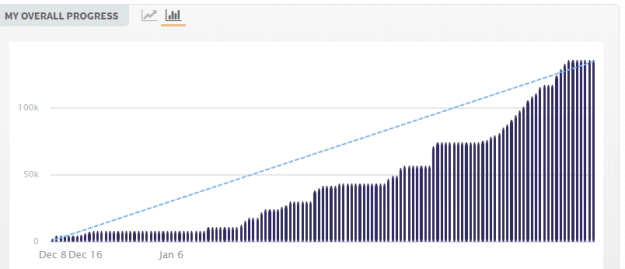
By the time I got back to it, around January 23rd, I felt despair. It was now 2020, two numbers had changed on the year part of the calendar since I’d started this project, and I was only at the beginning of the longest thing I’d ever written and that would STILL be garbage that I wouldn’t be able to send to an agent, even when it was done. By my calculation, if draft #2 worked as it should, I’d need at least 5 drafts to finish the book. Whenever friends asked how the book was going I mostly said “please kill me now.”
I was also realizing that the wordcount wasn’t coming along as I’d expected, when I got back to writing. I made it to 50,000 words at the end of February – a huge achievement, as much as I’d written for Nano! – and realized I wasn’t even a third done with the new outline for the draft. In the back of my mind, the awful math of how long writing this thing would actually take, and how long the journey would still be afterwards, began to weigh me down and slide into panic.
By March, I knew I had to lie to myself to keep going. I’d re-calculated how long the draft would take – by some calculation it went up to 150,000 – but I couldn’t stare at those impossible numbers. In April I was supposed to attend a local con, and between that and the holidays be away from writing for at least a few weeks. I had to finish the draft before that deadline, or risk getting distracted by life again and returning to the draft months later.
So I decided to play a game with myself. I kept my goal at 110,000 words – even though I knew that wasn’t realistic. But I needed to see that at-least-theoretically-achievable number every day.
I made desperate charts and calculations about how many words I’d need to get through every day to make that wordcount in time. I made myself believe that nothing but the graph mattered – as long as I could get to 110,000 words, I’d be OK. I was behind, sure, but I had a plan that was at least semi-realistic to reach 110,000. I’d give up whatever I had to, but I’d make it. A number higher than that was simply impossible.
Of course, this story has a surprise ending. In March, the pandemic hit. I was one of the extremely fortunate people who got sent home on what was essentially paid leave, at least for the first few weeks.
I took two days to relax and clear my head (the weeks before I was let go were especially hectic and stressful, I worked on the weekends and couldn’t write at all. You can see that as the long flat line, after I’d already gotten back to the swing of things.)
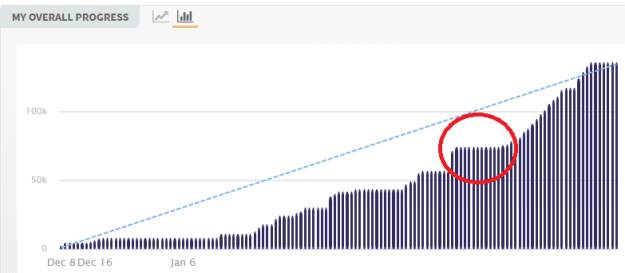
I then began writing every day, for at least 8 hours, until the book was done, a few days before my original deadline. You can see that in the remarkable, steep climb on the graph. Overall, I wrote 62,000 words in three weeks. Which, on the one hand, is something I’m amazed and pleased with, but on the other, underscores how unrealistic my original goals were.
The book ended up being 137,000 words, and there was absolutely no chance that I’d have finished it by the deadline I set myself, especially when the last third of it was almost entirely comprised of new scenes that had to be written from scratch.
As the days passed and I realized 110,000 wasn’t a realistic number, I changed the goal on the website to 120,000, and then 130,000 and then 135,000 (that’s what you’re seeing in these graphs – in reality, for me, the line was set much lower most of the time). All in a bid to keep myself from the despair of “oh god this will never end, this is so long, who can possibly read that many words as a beta???”
Each time I went from 85% done back to 75%, from 92% back to 85%. It was discouraging, but these small bouts of discouragement were better than if I’d faced the reality early on. If I’d known the draft would end up being 137,000 words, a number I had no chance of reaching by the end of April, or even the end of June, I might have just given up.
Consider that it took me 4 months to write 75,000 words, and then 3 weeks to write another 62,000. Even under the most optimistic circumstances, if I didn’t have time off because of the pandemic I’d have finished the draft sometime in July.
Thinking in December about how I was going to spend every waking, free moment writing the second draft – which again, would still not be good enough to show an agent – for the next 8 months, would have been unbearable. The only way I got through this ordeal was by lying to myself, each time, that the end was closer than I instinctively knew it was.
2. Logging (meaningless) wordcount and other tools for survival
I pretty much fell in love with NaNoWriMo’s website, and their stats and ability to log words and hours spent writing, from the moment I discovered them. I don’t really use any special tools for my writing – I write in Google Docs (because I usually write from 4-5 devices over the course of a week and I’ve found GDocs handles this better than Dropbox), I use spreadsheets, but other than that there’s no special software or tools I use.
Nano forced me to spend time getting to know their website in November 2019, so I didn’t have to spend extra time researching and learning their system, and now I swear by it.
For example, for this draft logging my wordcount was utterly meaningless. In a first draft you maybe want to reach a certain wordcount to make sure you have a novel and not a novella, but in a second draft, whether the book is 90,000 or 110,000 doesn’t matter. You also have no idea how long the text will end up being, so it’s not like a more advanced draft where you’re editing your manuscript for clarity and you know you have to get through a given amount of words.
For me, this second draft was about adding a whole bunch of stuff, and what that would do to my wordcount was pretty meaningless.
Still, I created the draft as a project on the Nano website and logged my words into it. I admit, in January I began to think that was a mistake. I’d gone so long without writing, catching up felt impossible and was only filling me an ultimately incorrect sense that I was behind schedule.
But I decided to give it a chance, still, and it really paid off. Even if I had to set fake goals for myself, it meant it was easier to decide how much time each week I was dedicating to writing, and to see that time reflected in wordcount. It was easier to plan and calculate, things that I find calming against the neverending anxiety of writing a book.
In the final stretch, when the pandemic hit, I was afraid that an extended time indoors will mean my schedule slowly falling apart. So, I took a notebook and made a list of all the scenes from the outline I still had to get through. I created two columns:
- has any work been done on this scene? If yes, I can draw a star for myself
- has work on this scene been completed? If yes, I get a star sticker. (Thank god I randomly bought those stickers right before stores closed!)
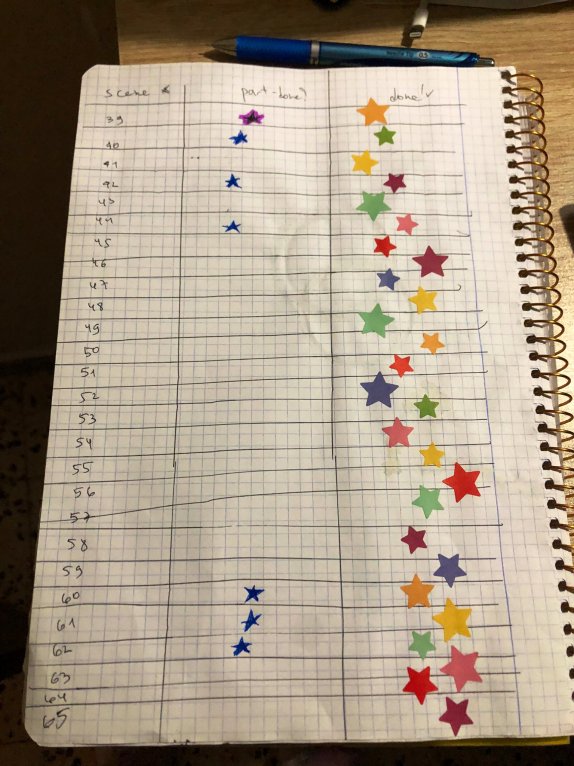
Like with my experiences with Nano, I learned that the kindergarten brain works. These small, meaningless, colorful rewards, that didn’t take any time to create, were still a great motivational tool, and gave me a very real, measurable sense of achievement.
Finally, my secret weapon.
Before the world was on fire, I used to go to a weekly writing group semi-regularly. As you might have guessed if you’ve read this far, I’m generally someone who’s pretty self-motivated with writing, and I’m good at carving out time between full-time work and disability, foregoing social outings, burying my mental and physical health, all because I want to get some writing done.
I always felt like the best thing about writing, the reason I’ve done it in some form or another my entire life, the reason it’s always my coping mechanism and my comfort, is that I don’t need anyone else to do it. I don’t depend on anyone else’s schedule or mood, I control 100% how much effort I put into it.
But slowly, over the past few years, the power of having a writing group has been annoyingly refuting everything I like to believe about what works best for me. Yes, a writing group absolutely helps, I’ve found, and that was especially true during self-isolation.
Once I was home because of the pandemic, I wrote every day. I was sitting there for 8+ hours, I was producing words, I was making great progress, everything worked.
And then my writing group started meeting every day, digitally. A bunch of us would get on Zoom (two people in the group had paid accounts with no time limits) and people would join whenever they started working and leave whenever they were done for the day. We would be in a video chat, with everyone’s mics muted, and essentially be working together in silence.
At first, I was skeptical. Did I really need other people staring at me while I was writing at home? Did I really need more motivation, when I was already writing every day? Wouldn’t this just be a distraction?
But the numbers – or in this case, stars – don’t lie. Once I joined the digital group I wrote better, and faster. I went from finishing a scene or a scene and a half a day, to finishing 2-3 scenes a day. I went from a star sticker a day at most, to two-three star stickers.

This was my set up. In the corner, behind the monitor, you can see my phone, on which the Zoom app was open. It was hidden enough that I could only see a sliver of it and my eyes were never distracted, but it was still an ever-present reminder that other people were working with me, we were occupying the same space, and that served to focus me and keep me from being distracted by Facebook or Twitter.
Another way this worked was that my phone was not available to me the entire time I was writing. If someone called me I would see it, but I didn’t get notifications from social media, texts, etc.
The writing group worked in sprints of 25 minutes, with 5 minute breaks in between (thanks to the tireless leadership of Rotem Baruchin). Aside from giving me necessary reminders to get up, stretch, make tea, etc., it also meant that I had 25 minutes of pure focus, with 5 minutes to then check messages and get back to people for urgent things, and then – 25 minutes of pure work again.
Of course I was mostly unavailable, and I missed talking to friends and doing social activities and watching events on Zoom, and generally everything else people have been doing to stay connected during These Times. But I was focused on finishing my novel draft, and just like all the nights I spent at home writing after work, this was a sacrifice I felt I had to make. I was fortunate that the writing group helped me get the most out of it.
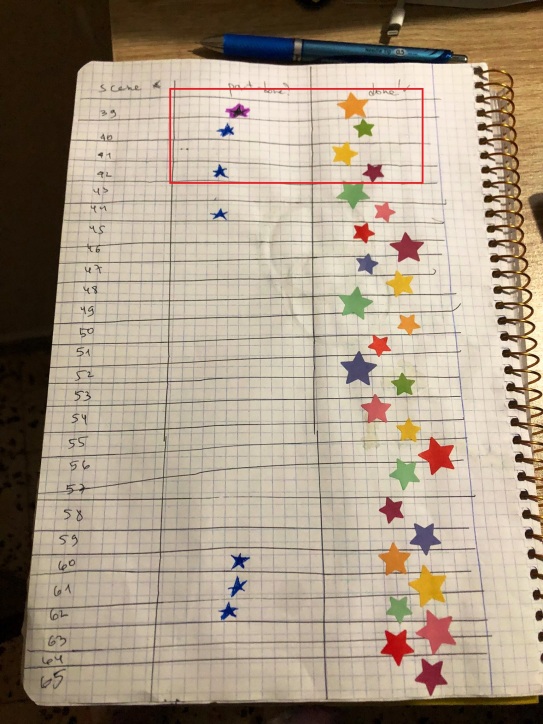
You can see, inside the square, the days I was writing before I joined the digital writing group. I thought I was doing well, but I would always have a scene I began working on but didn’t finish. But once the writing group came into my life, around scene 43, those unfinished days became much rarer.
(The blue stars in the bottom are the result of me running out steam after 16 consecutive days of writing for 8-10 hours a day, and when I saw that I wasn’t finishing scenes as much anymore, I knew I had to take a break, which I did. Two days for Passover!)
Anyway, the lesson here is, at least for me: writing groups work. No matter how motivated I am, no matter how annoying I find this fact, they are great tools for keeping me on track, keeping me focused, and making my output even better. I suspect I’m going to be learning that lesson over and over in the years to come because I find the belief that I Don’t Need Anyone Else To Write so precious.
Another thing I learned, mostly because of the pandemic and my fortunate circumstances of getting to stay home for weeks because of it, was about the writing-in-bursts versus writing-every-day method and how it relates to me.
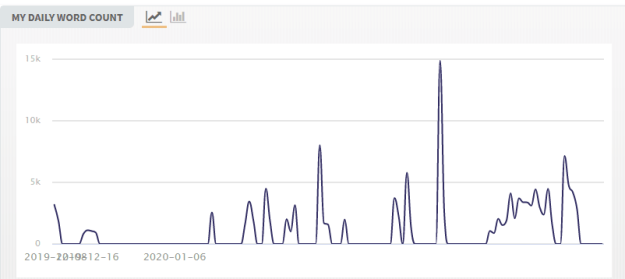
This is a graph of my daily word input. See that huge spike? That’s about 14,000 words. The zero period after it is the end of March, when my schedule was ridiculous because of the pandemic and I couldn’t write at all. The more consistent output afterwards are the three weeks I spent writing at home.
You can see that before the pandemic, I was actually writing waaay more words, on days when I was writing. At my most productive, when I was at home, towards the end, I wrote about 7,000. Most days I only wrote 2-4 thousand words a day.
There are a lot of reasons for this: because of disability I couldn’t spend as many hours sitting in a chair at home when I was at home ALL THE TIME, versus the amount of time I could spend writing when I had a day off amid an otherwise regular schedule.
But the amazing thing was that, when I was working I could only carve out a few days at a time to spend hours writing. Eventually I’d have some kind of interruption, event, just a bad day, and I’d have to stop. When I was at home, I wrote a lot less a day but accumulated much higher numbers.
Everything up to that huge spike is 75,000 words, everything after it is 62,000 words. The numbers are almost identical, but the time it took to reach them is vastly different.
I was never – and still am not – a believer in the “write every day” advice, which is simply not feasible for many people, but it’s amazing to see these stats of my own output. It’s also another benefit to logging meaningless wordcount – it gives you unexpected info like this on your own habits.
3. Amazingly, it does get easier
For me, every draft after the first draft was a complete mystery. Could I actually complete a novel, from an empty page to whatever a good-enough-to-send-to-an-agent draft looks like? I still don’t know.
I began writing Three Keys in the Desert about 13 years ago (it was then, and for many years afterwards, called Weeds on the Shoreline, until friends convinced me it was too literary and bland a name for a scifi mystery/adventure). I wrote the first draft in about 3 weeks (it was 21,000 words long). I returned it to it over the years, I created several drafts, I revised, I showed it to beta readers. All in all, it took about a decade from first draft to final version, and that was for a work that ended up being barely half of the average length of a novel.
I was terrified of how long writing an actual book would take me. The first draft was easy in that sense – I was making something from nothing. There’s an obvious achievement in that, a form of excitement. But what about subsequent drafts? Would I drown in rewrites and uncertainty? Would there ever be measurable progress?
So, I’m very happy and very relieved to report that for me, the second draft was easier.
The difference between this and the first draft is that I’m more confident now. I’ve already told this story once, start to finish, now I had to do it again, and that was less scary. Writing-wise, completing 80,000 words and then editing them, leveled-up both my confidence and my skills.
The prose is easier now (messy and unrefined as it is), editing really is quicker (at least when you have an outline). Mostly, it’s that I know what the full process of a draft looks and feels like, for me. I know I can start from this zero point and make this endless long journey, and finish it, and send this monster to readers, and get their feedback, and process it, and then do another round.
After the first draft, I know I can do that. The second draft, in that sense, felt both terrifying and new, but also familiar and more feasible and possible. The hard thing about everything after the first draft is that you’re coming closer and closer to the end of your ability to improve the text. Whether because it’s as good as you can make it (without taking a years-long break to level up through other projects) or because your ability to work on this one story is just over and done, but at some point the writing of this book will end and I’ll have to face the harsh reality of whether anyone wants to pay me to publish it.
And with every draft that statistically-likely resounding “no!” is coming closer, and psychologically that’s a challenge. In the first draft, it’s easier to say “whatever, this is still raw cookie dough, who knows what the final product will be”. In the second draft it’s harder to believe that, and I suspect will keep getting harder and I progress. The question of whether this is Good Enough becomes ever more persistent.
So, what is the book like now?
If you’ve read this far, you may be wondering what the draft is actually like. At least, I think I’d be wondering that. The answer is that I have official confirmation from people who’ve read both drafts that this one is Objectively Much Better, which is a huge comfort considering how much time and energy I spent on it.
Devstatingly, the beta readers who’ve gotten back to me so far have also said they see nothing that should be cut from this 137,000 word monster, and in fact, if anything, the story should be exapanded. /o\ THIS IS FINE. EVERYTHING IS FINE. I’m not at all breathing into a paper bag.
Anyway, last time on a post like this I gave you a sample of prose, and I’m delighted to say I can’t really give you the same passage as it exists in the new draft – because it simply doesn’t exist. I rewrote the entire beginning of the book quite heavily, and that scene doesn’t exist anymore.
So, instead I’ll give you what are now the opening paragraphs of the book:
Elro watched the cup leave her fingers, fall down ever so slowly, as if it were made of paper and not precious ceramics, before it shattered on the floor. It was empty now, and therefore useless. She needed another one, full of wine.
“Your Highness!” someone said, next to her. It was the representative of Clan Haldufi, a short woman, old enough to be a grandmother. The five clans never sent their best to Karaya, not even for a royal wedding. Not even to witness a queen taking her first husband.
Although, technically speaking, Elro was not yet a queen.
